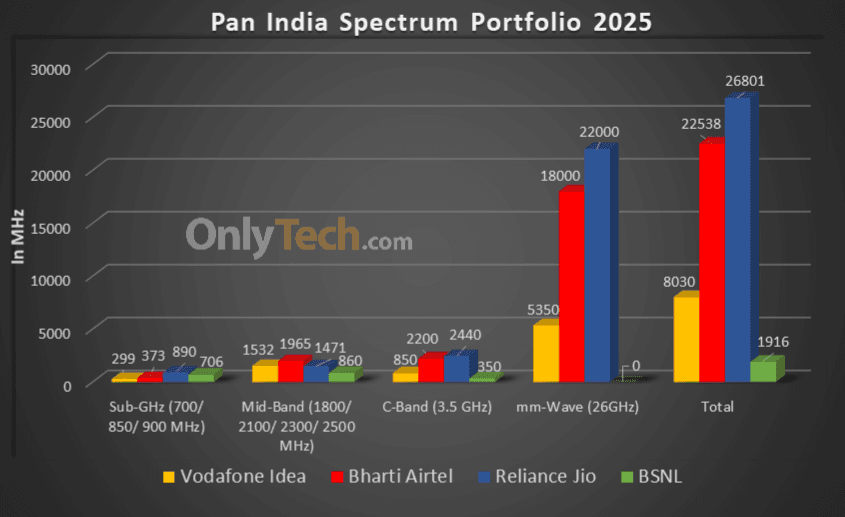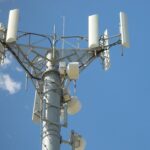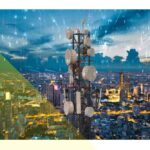Spectrum is for telecommunication what jet fuel is for aviation. Spectrum is a range of electromagnetic frequencies or airwaves that telecom companies use for establishing a connection between a cell tower and a mobile phone. The bandwidth of this spectrum is directly proportional to the speed of a wireless data network (since more data can be transmitted simultaneously through a broader data pipeline). In contrast, the frequency is inversely proportional to the coverage (since lower frequencies penetrate better through physical barriers and thus have wider coverage).
The spectrum holding data sheet embedded in this article represents the current spectrum holdings of all active telecom operators across all frequency bands across all 22 telecom circles along with their liberalisation status and expiry dates. All figures represented are in MHz. The value mentioned in the bracket beside the frequency at the base of each sheet is the band number where ‘B’ stands for 4G LTE band whereas ‘n’ stands for the corresponding 5G NR band.
The spectrum shown under BSNL and Aircel in white is reserved for the respective operators but has not yet been officially allotted to them.
Spectrum Liberalisation:
Spectrum was administratively allocated to operators in each of the 22 licensed service areas or circles prior to 2010, this spectrum is called non-liberalised and can only be used for 2G services whereas all airwaves allotted post-2010 have been through a Spectrum Auction where operators have paid the market discovered price and this spectrum is called liberalised and can be used for any technology platform 2G/3G/4G/5G. Alternatively, operators may choose to liberalise their administratively allotted spectrum by paying the market-discovered price to DoT on a pro-rata basis for the remaining validity of the spectrum.
Paired and Unpaired spectrum:
Spectrum may be paired or unpaired, bands 1/3/5/8/28 are all paired where one set of frequencies is used for uplink whereas another distinct set of frequencies is used for downlink known as Frequency-division duplexing (FDD), whereas bands 40/41/78/258 are unpaired where both uplink and downlink happens in the same set of frequencies separated by the time of uplink and downlink known as Time-division duplexing (TDD).
List of Indian FDD Bands:
| 4G LTE band | 5G NR band | Uplink frequency range (MHz) | Downlink frequency range (MHz) | Bandwidth for telecom (MHz) | Block size (MHz) |
|---|---|---|---|---|---|
| B1 | n1 | 1939-1979 | 2129-2169 | 40×2 | 5×2 |
| B3 | n3 | 1710-1780 | 1805-1875 | 70×2 | 0.2×2 |
| B5 | n5 | 824-844 | 869-889 | 20×2 | 1.25×2 |
| B8 | n8 | 890-915 | 935-960 | 25×2 | 0.2×2 |
| B28 | n28 | 723-733/ 738-748 | 778-788/ 793-803 | 20×2 | 5×2 |
List of Indian TDD Bands:
| 4G LTE band | 5G NR band | Frequency range (MHz) | Bandwidth for telecom (MHz) | Block size (MHz) |
|---|---|---|---|---|
| B40 | n40 | 2300-2380 | 80 | 10 |
| B41 | n41 | 2535-2555/ 2615-2655 | 60 | 10 |
| – | n78 | 3300-3670 | 370 | 10 |
| – | n258 | 24250-27500 | 3250 | 50 |
Spectrum caps:
A spectrum cap dictates how much spectrum a particular operator can hold in a circle for a specific band. There is a 40% cap for Sub-GHz spectrum in the 700/850/900 MHz bands combined, a 40% cap for Mid-Band spectrum in the 1800/2100/2300/2500 MHz bands combined, a 40% cap for the C-Band spectrum of 3300-3670 MHz and a 40% cap for the mm-Wave spectrum bands of 24.25-27.5 GHz. The current spectrum caps are denoted in the spectrum chart.
Overall spectrum holdings of operators (in MHz):
| Operator/Holding | Jio | Airtel | Vi | BSNL |
|---|---|---|---|---|
| Sub-GHz | 890 | 373.2 | 298.8 | 706 |
| Mid Band | 1470.8 | 1964.9 | 1531.6 | 860 |
| C-Band | 2440 | 2200 | 850 | 350 |
| mm-Wave Band | 22000 | 18000 | 5350 | 0 |
| Total | 26,800.8 | 22,538.1 | 8,030.4 | 1,916 |
Spectrum sharing/trading/leasing guidelines:
- Telecom operators holding CMTS/UASL/UL licenses can enter into a Spectrum-Sharing agreement with each other so long as both parties hold liberalised spectrum in the same band in the same circle. Spectrum sharing is possible only on a Pan LSA level in block sizes defined by DoT and only after one year of an operator acquiring the spectrum.
- Telecom operators holding CMTS/UASL/UL licenses can enter into a Spectrum-Trading agreement with each other so long as the spectrum being sold is liberalised. Trading of spectrum is possible only on a Pan LSA level in block sizes defined by DoT and only after two years of an operator acquiring the spectrum.
- Telecom operators may enter into a Spectrum-Leasing agreement only with Enterprises holding a Captive Non-Public Network (CNPN) license and not with each other. The lease may be limited to any geographic area within the LSA and for any duration mutually agreed upon by both parties. A CNPN licensee can lease spectrum from multiple operators within an LSA.
Note: We update this chart in real-time to ensure it is always up to date with the latest changes in spectrum holding. Certain human errors might have crept in during the manual compilation of the data, any mistakes/ rectification can be brought to the Team’s notice through the comments section below.








@Ankit Kumar: How much speed you are getting in Jio B5 (Rajasthan)? How much spectrum deployed by Jio in B5 in Rajasthan ? Also did Jio deploy 20 Mhz in LTE in B3 in Rajasthan acquired recently ? Also did Jio deploy 10 mhz in Assam, North East, J&K , UP (West) in B5 acquired in recent auction. Please make a video on your channel for the same.
Newly won spectrum is yet to be allotted to the operators, which is most likely scheduled to happen tomorrow as per Ashwini Vaishnav’s comments. Only after that can we expect to see it implemented.
Will the spectrum be allocated today? Cuz payment were moved to 17th August
Which bands will be used by Airtel for 5g in initial deployment apart from n77/78 and mmWave ?
1800 or 2100 MHz bands for now
Non use of 1800 or 2100 Mhz will make Airtel 4G dead cat.
Airtel 4G sucks big time in most parts of the country anyway. However, going by the spectrum holdings in these 2 bands, Airtel has strengthened its position in the last 2 auctions. It remains to be seen if their 5G NSA is bad as their 4G. I don’t have high hopes.
Will it not detriote 4G quality which is already running at its peak ?
Possibly. Gopal Vittal stated that B1 and/or B3 will be used to complement downlink on n78. It means that since it’s 5G on non-standalone mode, the 100 MHz on n78 will be used purely for downlink while the 4G bands will facilitate the uplink and downlink. The core that’s going to be used in this case will the same 4G core that Airtel has been using for a long time, thus the entire traffic on 5G will be routed through it. If Airtel doesn’t scale up its core and improve the backhaul customers will face service quality issues. The point is that issues may happen not because of the spectrum but because of backhaul and core.
Yes, though Airtel is going for NSA 5G so it will be using n78 for downlink while shifting the uplink portion to the mid band 1800 and 2100 MHz bands. Thus ensuring faster 5G speeds and enhancing the coverage radius of n78 as compared to SA 5G implementation.
@esmail So will Airtel dynamically adjust the bandwidth in 1800 and 2100 or particularly allocat some spectrum for 5G ? Also is it true that 700Mhz radios use more power than say existing 850 or 900Mhz band ?
Yes Airtel will deploy Dynamic spectrum sharing (DSS) for bands 1 and 3 to have it allocate bandwidth to 4G and 5G depending on the type of devices connected to the towers.
The radios for 700 MHz consume nearly the same amount of power as the 850 and 900 MHz radios.
There are a lot of fundamental challenges with DSS. Firstly, the QoS is poor: battery drains a lot faster and speeds are almost the same as 4G, sometimes even lower. Cases in point – AT&T and Verizon’s deployment of their “nationwide” 5G services in the US. Secondly, 5G Carrier aggregation is not possible on DSS.